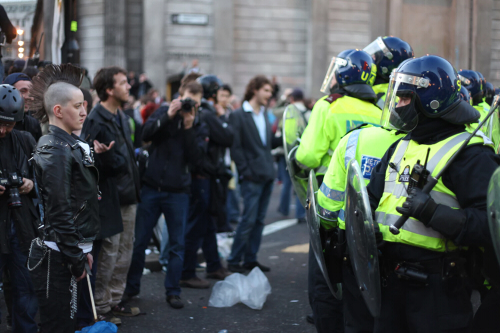The Battered Blue Line
破旧的蓝色警戒线
As hundreds of thousands of people marched peacefully through central London in a rally against the government’s spending cuts on March 26th, a hundred or so vandals, thought to be extreme anarchists and anti-capitalists, rampaged nearby. Banks and upmarket retailers near The Economist’s offices still bear the scars of the mayhem. Not for the first time, the Metropolitan Police stands accused of mishandling the unrest.
3月26日,成百上千的游行者和平的走过伦敦中央,抗议政府削减开支,这时一百多个暴民在附近进行大肆破坏,他们是极端无政府主义以及反资本主义者。在《经济学人》办公室附近的银行和奢侈品零售商还保留着暴力混乱的伤痕。伦敦的警察已经不是第一次被责备没有处理好动荡了。
Even when attacked with missiles – including, reportedly, ammonia-filled lightbulbs – officers were restrained. They stood off as shop fronts were trashed and small fires were lit. (Fewer than ten people have been charged for crimes relating to violence, though many more for the aggravated trespass of Fortnum & Mason, a department store in which demonstrators staged a mostly peaceful sit-in.) There seemed little excuse for being caught out by the trouble: it had been planned online; there was violence at a protest against higher university-tuition fees three months earlier.
就算是遭到投掷物的袭击——据说包括充满氨气的电灯泡——警察们都十分控制,没有采取回击。商店门面被砸碎,有小火点燃,他们都不上前阻止。(少于10人因暴力而遭到指控,但有更多的人在百货大楼Fortnum & Mason的静坐抗议活动后被逮捕,静坐大部分时间是和平的,但后来情况有所恶化。)警方不应有任何借口对此次冲突毫无防备:这次游行是通过网络计划的;而且3个月前抗议大学提高学费时也有暴力发生。

Yet the police could be forgiven for feeling exasperated by this criticism. After all, their handling of some previous demonstrations in London was condemned as too harsh. The tactic of “kettling” protesters – detaining them for extended periods within cordons of officers – has attracted controversy. The case of Ian Tomlinson, who was pushed to the ground by a police officer during a protest in 2009 and later died, is the subject of an ongoing inquiry.
人们应该原谅警方对此类批评表示愤怒。毕竟他们曾经被谴责在处理的一些伦敦的抗议时太过严厉。他们“软攻”抗议者的方式——即将他们长时间围困在警戒线内——引起了争议。Ian Tomlinson在2009年的一次游行中被一名警官推倒在地并且后来丧了命,这一案例便是人们一直询问的主题。
It might be impossible to strike a Goldilocks-style balance – neither too tolerant nor too tough – that would please everybody. But there is a palpable need for consistent rules of engagement. There are likely to be more big marches in the coming years, as the government’s cuts bite. Even Prince William’s wedding to Kate Middleton on April 29th is purportedly being targeted by unruly demonstrators.
若想以金发姑娘式的平衡罢工——即不显软弱又不过于激烈——来取悦所有的人,似乎不太可能。但至少我们需要一个一致的规则来处理这类问题。在接下来的几年里,政府削减开支的结果一一显露,很有可能会有更大的游行。甚至威廉王子和凯特在4月29日的婚礼都传言将成为那些无法管制的游行示威者的目标。
On March 28th Theresa May, the home secretary, said that she would consider giving the police more powers for future protests. Preventive measures that helped to ease Britain’s once-endemic problem of football hooliganism could be adopted. For example, rogue elements could be banned from attending marches (though this would be harder to enforce than a ban on a hooligan entering a stadium). Mrs May hinted that the police should use existing powers to force protesters to remove the balaclavas and face-coverings often worn by rioters. Many would like her to go further. Andy Hayman, a former assistant commissioner of the Met, suggests dawn raids on known troublemakers’ homes.
3月28日,内政大臣Theresa May说她想给警察更多的权力来应对未来的抗议活动。政府可以采用曾经用来减缓英国一时成灾的足球流氓问题的防御措施。例如可以人们禁止参加游行时使用危险器械(虽然这比禁止流氓进入场馆要难实施得多)。May女士暗示到警察应运用现有的权力来强迫抗议者摘下那些劫贩经常带的巴拉克拉瓦帽以及面罩。很多人希望她能更进一步将想法付诸实践。前警察局局长助理安迪·海曼(Andy Hayman)建议对那些已证实的闹事者进行黎明突袭。
New rules and powers, however, will only help to deal with the most hardened and violent rioters. A larger, trickier group are clever enough to cause trouble while staying within whatever laws prevail at the time. Disruption and intimidation that stops short of actual violence are becoming their speciality.
然而新的规则和权力也只能用来对付那些最为极端的暴力抗议者。有一部分人十分聪明,他们可以在不违背当时存在的任何法律的前提下制造麻烦,而且这一部分人人数更多,更难对付。他们最擅长的是在不发生真正暴力的情况下进行破坏及恐吓。
In any case, the allegedly lax line taken by the police towards the violence probably has less to do with their powers than with fears of being accused of brutality. Britain has lived through angry political epochs before: there were riots against the “poll tax” in 1990, for example. But in those days a police officer’s every action was not filmed on protesters’ mobile-phone cameras. The technology enables scrutiny. It also risks shaping a policing strategy that errs on the side of passivity.
不管怎样,传言中警察对暴力事件管制极为克制这件事可能与他们的权力没有太大关系,更重要的是他们害怕被指责过于野蛮。英国曾经经历过愤怒的警察的时代:比如1900年时曾经因为“投票税”而发生过暴乱。但那个年代警官的一举一动并不会被抗议者的手机相机录下来。科技使人们能够更为仔细严格的审查。但科技同时也有可能造成错误的警务战略,使其变得更被动。
英文、中文版本下载:http://www.yingyushijie.com/shop/source/detail/id/990.html








